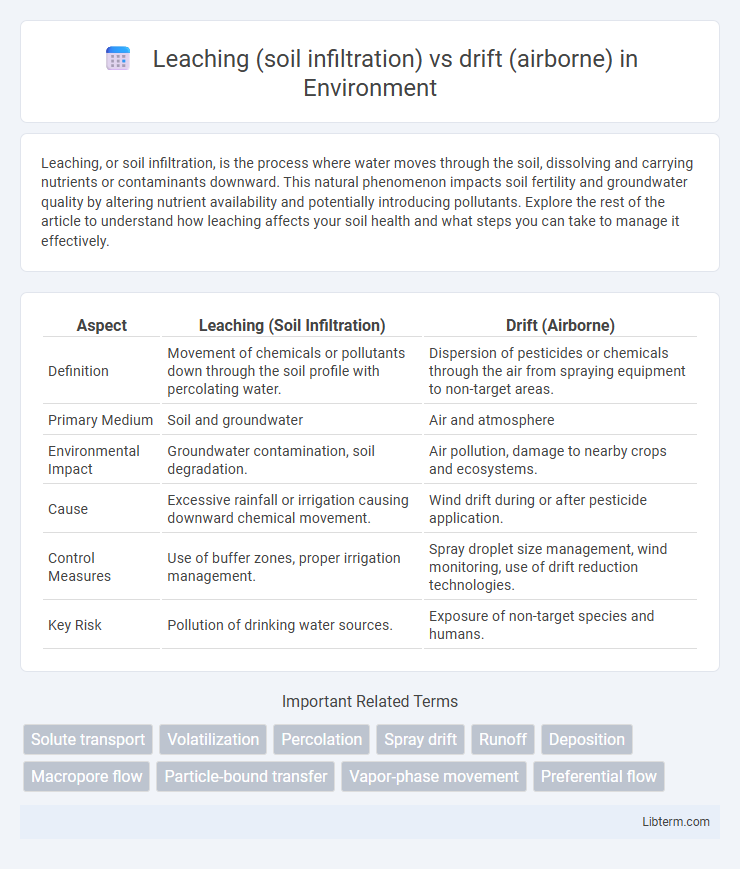Leaching, or soil infiltration, is the process where water moves through the soil, dissolving and carrying nutrients or contaminants downward. This natural phenomenon impacts soil fertility and groundwater quality by altering nutrient availability and potentially introducing pollutants. Explore the rest of the article to understand how leaching affects your soil health and what steps you can take to manage it effectively.
Table of Comparison
| Aspect | Leaching (Soil Infiltration) | Drift (Airborne) |
|---|---|---|
| Definition | Movement of chemicals or pollutants down through the soil profile with percolating water. | Dispersion of pesticides or chemicals through the air from spraying equipment to non-target areas. |
| Primary Medium | Soil and groundwater | Air and atmosphere |
| Environmental Impact | Groundwater contamination, soil degradation. | Air pollution, damage to nearby crops and ecosystems. |
| Cause | Excessive rainfall or irrigation causing downward chemical movement. | Wind drift during or after pesticide application. |
| Control Measures | Use of buffer zones, proper irrigation management. | Spray droplet size management, wind monitoring, use of drift reduction technologies. |
| Key Risk | Pollution of drinking water sources. | Exposure of non-target species and humans. |
Understanding Leaching and Drift: Key Definitions
Leaching refers to the downward movement of water-soluble chemicals or nutrients through soil layers, potentially contaminating groundwater, while drift involves the airborne transport of pesticides or particles beyond the target area during application. Understanding leaching is crucial for managing soil infiltration rates and preventing groundwater pollution, whereas drift control focuses on reducing off-target pesticide exposure and environmental impact. Effective agricultural practices employ buffer zones, proper irrigation, and formulation adjustments to minimize both leaching and drift risks.
Mechanisms of Soil Infiltration by Leaching
Leaching involves the downward movement of water and dissolved substances through soil layers, driven primarily by gravity and soil permeability. This process transports nutrients or contaminants from the soil surface to deeper horizons, influencing groundwater quality and plant root access. Soil texture, structure, and organic matter content significantly affect infiltration rates and the efficiency of leaching as a mechanism for solute redistribution.
Airborne Movement: The Process of Drift
Drift in airborne movement refers to the unintentional dispersal of pesticides or chemicals through air currents during or after application, leading to contamination of non-target areas. Factors influencing drift include droplet size, wind speed, temperature, and humidity, which affect the distance and direction chemicals travel. Effective management practices employ nozzle selection, application timing, and buffer zones to minimize airborne drift and its environmental impact.
Main Factors Influencing Leaching in Soil
Leaching in soil is primarily influenced by soil texture, organic matter content, and precipitation patterns, which determine the rate at which water and dissolved substances infiltrate and move through the soil profile. Sandy soils with low organic matter exhibit higher leaching potential due to larger pore spaces and reduced adsorption capacity, while clay-rich soils retain more nutrients, limiting leaching. Excessive rainfall or irrigation can exacerbate leaching by increasing water percolation beyond the root zone, contrasting with drift, where wind speed, droplet size, and atmospheric conditions control the airborne spread of substances.
Environmental Variables Affecting Drift
Environmental variables affecting drift include wind speed, direction, temperature, and humidity, which influence the distance and dispersion pattern of airborne pesticides. Higher wind speeds increase drift potential by carrying particles farther from the target area, while temperature inversions can trap pesticides close to the ground, intensifying off-target contamination. Soil moisture and texture indirectly affect drift by altering pesticide volatilization rates, thereby impacting atmospheric concentrations.
Chemical Properties Impacting Leaching vs Drift
Chemical properties such as solubility, volatility, and adsorption significantly influence pesticide behavior in the environment. High water solubility and low soil adsorption increase leaching potential, causing chemicals to move downward in soil and contaminate groundwater. In contrast, high vapor pressure and low molecular weight enhance drift by promoting airborne dispersion during or after application.
Agricultural Practices: Minimizing Leaching and Drift Risks
Effective agricultural practices to minimize leaching involve precise irrigation management, use of slow-release fertilizers, and maintaining organic matter to enhance soil's water retention capacity. Reducing drift requires selecting appropriate nozzles, spraying during low wind conditions, and applying pesticides at optimal droplet sizes to ensure targeted deposition. Integrating buffer zones and adopting precision agriculture technologies further mitigates environmental contamination from both leaching and drift.
Environmental Consequences: Soil Contamination vs Air Pollution
Leaching causes soil contamination by transporting harmful chemicals and pollutants deep into the soil layers, affecting groundwater quality and disrupting soil microbial ecosystems. Drift results in air pollution by dispersing pesticides and particulate matter into the atmosphere, leading to respiratory issues in humans and harming non-target plants and animals. Both processes have significant environmental consequences, with leaching primarily degrading soil health and water resources, while drift contributes to widespread air quality deterioration and ecosystem damage.
Regulatory Guidelines for Managing Leaching and Drift
Regulatory guidelines for managing leaching emphasize soil infiltration control through proper pesticide application rates and timing to prevent groundwater contamination, as outlined by the EPA's Groundwater Protection Rule. Drift management regulations focus on minimizing airborne pesticide movement by enforcing buffer zones, wind speed restrictions, and spray nozzle technology standards per the EPA's Worker Protection Standard and state-level drift control policies. Compliance with these guidelines ensures reduced environmental impact and aligns with integrated pest management (IPM) practices promoting sustainable agriculture.
Best Practices for Sustainable Land and Pesticide Management
Leaching occurs when pesticides infiltrate the soil, potentially contaminating groundwater, while drift involves airborne pesticide particles moving off-target, affecting nearby ecosystems. Best practices for sustainable land and pesticide management include precise application techniques such as soil incorporation and controlled spray methods, ensuring optimal timing and weather conditions to minimize off-target movement. Employing buffer zones, selecting low-volatility formulations, and integrating integrated pest management (IPM) principles further reduce environmental impact and enhance long-term soil and water quality.
Leaching (soil infiltration) Infographic

 libterm.com
libterm.com